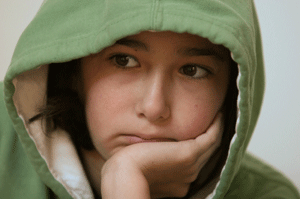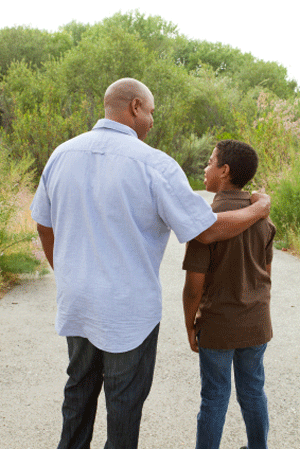
Anxiety is a normal reaction to the stresses of life. A case of the jitters isn’t necessarily harmful; in fact, it can spur us to be at our best. Ordinarily, stressful situations prompt a flurry of brain and hormonal activities, in what is called the fight-or-flight response. Body systems mobilize to meet the challenge, and a person feels more alert, focused and energetic.
An anxiety disorder, by contrast, can be incapacitating. It is an illness, one that frequently runs in families. The anxiety may be overwhelming—and at times terrifying—or it may be relatively mild but incessant, often with no apparent cause. A young person has nearly a one-in-seven chance of developing an anxiety disorder, which is the most common mental health condition among all age groups. The context in which anxiety symptoms are produced primarily differentiates the specific anxiety disorders. Below are commonly encountered specific disorders. Other anxiety disorders such as obsessive-compulsive disorders (OCD), post-traumatic stress disorder (PTSD) and specific phobias will not be discussed in this newsletter but parents can check on the links below for further information.
1. General Anxiety Disorder: is characterized by chronic and excessive worry in an number of areas (e.g., school work, social interactions, family, health/safety, world events) that is difficult to control. This condition often coexists with depression. These adolescents are often conforming perfectionists who constantly seek approval and reassurance. They find it difficult to control the worry. Below are common symptoms:
- Restlessness or feeling keyed up or on edge
- Being easily fatigued
- Difficulty concentrating or mind going blank
- Irritability
- Muscle tension
- Sleep disturbance
2. Phobias: are exaggerated and usually inexplicable fears that center on specific objects or situations. These intense fears can limit a teenager’s activities. The fear generated by a phobia is excessive and not a rational response to a situation. The objects of a phobia usually change as a child gets older. While very young children may be preoccupied with the dark, monsters, or actual dangers, adolescents’ phobic fears tend to involve school and social performance (social phobias).
3. Panic Disorder: More common in girls than boys, panic disorder emerges in adolescence usually between the ages of fifteen and nineteen. Feelings of intense panic may arise without any noticeable cause or they may be triggered by specific situations, in which case they are called panic attacks. A panic attack is an abrupt episode of severe anxiety with accompanying emotional and physical symptoms.
Distinguishing among normal fears and worries, temperamental variation, and clinically significant anxiety may be challenging. However, anxiety disorders are common in the pediatrics population, and efforts to identify these children should be made as effective treatments are available.
Identifying the Signs

Anxiety during adolescence typically centers on changes in the way the adolescent’s body looks and feels, social acceptance, and conflicts about independence. When flooded with anxiety, adolescents may appear extremely shy. They may avoid their usual activities or refuse to engage in new experiences. They may protest whenever they are apart from friends. Or in an attempt to diminish or deny their fears and worries, they may engage in risky behaviors, drug experimentation, or impulsive sexual behavior.
Several studies have revealed an increase in school avoidance in middle-school or junior-high years. With school avoidance, excessive worries about performance or social pressures at school may be at the root of the reluctance to attend school regularly. Some youngsters are naturally more timid than others. As their bodies, voices, and emotions change during adolescence, they may feel even more self-conscious. Despite initial feelings of uncertainty, most teens are able to join in if given time to observe and warm up. In extreme cases, then called social phobia, the adolescent becomes very withdrawn, and though he wants to take part in social activities, he’s unable to overcome intense self-doubt and worry.
Gripped by excessive or unreasonable anxiety when faced with entering a new or unfamiliar social situation, the adolescent with social phobia becomes captive to unrelenting fears of other people’s judgment or expectations. This leads to a cycle of anxiety, physical complaints, and school avoidance. The cycle escalates with the worsening of physical complaints such as muscle tension and cramps, stomachaches, headaches, pain in the limbs and back, fatigue, or discomforts associated with pubertal changes. They may blotch, flush, sweat, hyperventilate, tremble, and startle easily. Visits to the doctor generally fail to uncover general medical explanations. The longer a teenager stays out of school, the harder it becomes for him to overcome his fear and anxiety and return to school. He feels increasingly isolated from school activities and different from other teens.
When experiencing a panic attack, the youngster may feel overwhelmed by an intense fear or discomfort, a sense of impending doom, the fear he’s going crazy, or sensations of unreality. Accompanying the emotional symptoms may be shortness of breath, sweating, choking, chest pains, nausea, dizziness, and numbness or tingling in his extremities. During an attack, some teens may feel they’re dying or can’t think. Following a panic attack, many youngsters worry that they will have other attacks and try to avoid situations that they believe may trigger them. Because of this fearful anticipation, the teen may begin to avoid normal activities and routines.
Causes and Consequences
Most researchers believe that a predisposition towards timidity and nervousness is inborn. If one parent is naturally anxious, there’s a good chance that their child will also have anxious tendencies. At the same time, a parent’s own uneasiness is often communicated to the child, compounding the child’s natural sensitivity. A cycle of increasing uneasiness may then be established. By the time this child reaches adolescence, his characteristic way of experiencing and relating to his world is tinged with anxiety. Some research suggests that children who are easily agitated or upset never learned to soothe themselves earlier in life.
School avoidance can follow a significant change at school, such as the transition into middle school or junior high. It may also be triggered by something unrelated to school, such as a divorce, illness, or a death in the family. Some youngsters become fearful about gang activities or the lack of safety in school.
Most teens experience more stress when they perceive a situation as dangerous, difficult, or painful and they do not have the resources to cope. Some sources of stress for teens might include:
- School demands and frustrations.
- Negative thoughts and feelings about themselves.
- Changes in their bodies.
- Problems with friends and/or peers at school.
- Unsafe living environment/neighborhood.
- Separation or divorce of parents.
- Chronic illness or severe problems in the family.
- Death of a loved one.
- Moving or changing schools.
- Taking on too many activities or having too high expectations.
- Family financial problems.
A worried teenager performs less well in school, sports, and social interactions. Too much worry can also result in a teenager’s failing to achieve to his potential. A teen who experiences a great deal of anxiety may be overly conforming, perfectionistic, and unsure of himself. In attempting to gain approval or avoid disapproval, he may redo tasks or procrastinate. The anxious youngster often seeks excessive reassurance about his identity and whether be is good enough.
Some teenagers with anxiety disorders can also develop mood disorders or eating disorders. Some teenagers who experience persistent anxiety may also develop suicidal feelings or engage in self-destructive behaviors; these situations require immediate attention and treatment. Anxious teens may also use alcohol and drugs to self-medicate or self-soothe or develop rituals in an effort to reduce or prevent anxiety.
How to Respond

By helping him trace his anxiety to specific situations and experiences, you may help him reduce the overwhelming nature of his feelings. Reassure him that, although his concerns are real, in all likelihood he will be able to handle them and that as he gets older, he will develop different techniques to be better able to deal with stress and anxiety.
Remind him of other times when he was initially afraid but still managed to enter into new situations, such as junior high school or camp. Praise him when he takes part in spite of his uneasiness. Point out that you are proud of his ability to act in the face of considerable anxiety. Remember, your teenager may not always be comfortable talking about feelings that he views as signs of weakness. While it may seem at the moment as though he’s not listening, later he may be soothed by your attempts to help.
If fearfulness begins to take over your teenager’s life and limit his activities, or if the anxiety lasts over six months, schedule an appointment with him in our office. His doctor will be able to recommend a child and adolescent counselor, psychiatrist or other professional specializing in treating anxiety.
Managing anxiety disorders – as with any adolescent emotional disturbance – usually requires a combination of treatment interventions. The most effective plan must be individualized to the teenager and his family. While these disorders can cause considerable distress and disruption to the teen’s life, the overall prognosis is good.
Treatment for an anxiety disorder begins with an evaluation of symptoms, family and social context, and the extent of interference or impairment in the teen’s life. Parents, as well as the teenager, should be included in this process. School records and personnel may be consulted to identify how the teen’s performance and function in school has been affected by the disorder.
Your doctor will also consider any underlying physical illnesses or diseases, such as diabetes, that could be causing the anxiety symptoms. Medications that might cause anxiety (such as some drugs used in treating asthma) will be reviewed. Since large amounts of caffeine, in coffee or soft drinks, can cause agitation, a clinician might look at the youngster’s diet as well. Other biological, psychological, family, and social factors that might predispose the youngster to undue anxiety will also be considered.
If a teenager refuses to go to school, a clinician will explore other possible explanations before labeling it school avoidance. Perhaps the teen is being threatened or harassed, is depressed, or has an unrecognized learning disability. He may also be skipping school in order to be with friends, not from anxiety about performance or separation.
If the teenager has engaged in suicidal or self-endangering behavior, is trying to self medicate through alcohol or drug use, or is seriously depressed, these problems should be addressed immediately. In such cases, you need to call your physician right away and sometimes hospitalization may be recommended to protect the youngster.
In most cases, treatment of anxiety disorders focuses on reducing the symptoms of anxiety, relieving distress, preventing complications associated with the disorder, and minimizing the effects on the teen’s social, school, and developmental progress. If the problem manifests in school avoidance, the initial goal will be to get the youngster back to school as soon as possible.
Management
For youngsters with mild symptoms of anxiety and limited impairment in functioning, education, and guidance may be sufficient. For those with higher levels of symptomatology and impairment, a referral to a mental health specialist for psychotherapy, and possibly medication, should be initiated.
- Parent education and guidance. The first step in management is to educate both parents and children about the disorder. The discussion should include information about the symptoms of the disorder, course, treatment options, risks of treatment, and consequences of not seeking treatment. Parents and children are given concrete suggestions and techniques for how to deal with the symptoms at home and at school. Parents should try to attend to their child’s concern and help children to prepare for anxiety-producing transitions by practicing new routines and exploring new environments. They should try not to let children restrict their daily activities because of their anxiety.
- Cognitive behavior therapy (CBT). Substantial evidence exists supporting the use of CBT in the treatment of pediatric anxiety disorders. CBT is a time-limited, goal-directed therapy in which patients learn to react in a different way to situations that are anxiety producing. Children learn to manage their somatic symptoms (cramps, stomachaches, headaches), restructure how they think about anxiety-provoking situations, face their fears via exposure techniques, and make plans for what to do if anxiety returns. A widely utilized CBT protocol known as the Coping Cat program consists of 14-18 sessions over 3-4months. Given the significant role that parents play and family may play in the development and maintenance of anxiety symptoms, parents are frequently involved in the CBT treatment process.
- Group psychotherapy. Group therapy may help children with a social phobia confront their fears and facilitate positive interactions in an accepting group of people with shared problems.
- Medication. When symptoms are severe, a combination of therapy and medication may be used. A family of medications called selective serotonin reuptake inhibitors (SSRI), such as sertraline (Zoloft), fluoxetine (Prozac), paroxetine (Paxil), are the first-line medications used in children with anxiety disorders. It may take 4 weeks to see an effect and the dosage of medicine is adjusted overtime for maximal benefit and minimal side effect. Studies have shown that CBT and medications such as Prozac are equally effective in reducing symptoms of anxiety compared with placebo, while a combination of CBT and medication was superior to either therapy alone.
- School. An Individualized Education Plan (IEP) or 504 plan may be needed to help the student handle anxiety in school. The teacher may also need to be educated about the disorder, and provided with strategies for how to best help the child with anxiety in the classroom.
Teens can also decrease stress with the following behaviors and techniques:
- Exercise and eat regularly.
- Have a regular sleep routine with at least 8 hours of sleep a night.
- Avoid excess caffeine intake, which can increase feelings of anxiety and agitation.
- Avoid illegal drugs, alcohol and tobacco.
- Learn relaxation exercises (abdominal breathing and muscle relaxation techniques).
- Develop assertiveness training skills. For example, state feelings in polite, firm and not overly aggressive or passive ways: (“I feel angry when you yell at me” “Please stop yelling.”)
- Rehearse and practice situations, which cause stress. One example is taking a speech class if talking in front of a class makes you anxious.
- Learn practical coping skills. For example, break a large task into smaller, more attainable tasks.
- Decrease negative self talk: challenge negative thoughts about yourself with alternative neutral or positive thoughts. “My life will never get better” can be transformed into “I may feel hopeless now, but my life will probably get better if I work at it and get some help.”
- Learn to feel good about doing a competent or “good enough” job rather than demanding perfection from yourself and others.
- Take a break from stressful situations. Activities like listening to music, talking to a friend, drawing, writing, or spending time with a pet can reduce stress.
- Build a network of friends who help you cope in a positive way.
Sources for parents
Dacey JS, Fiores LB. Your anxious Child: How Parents and Teachers Can Relieve Anxiety in Children. San Francisco: Jossey-Bass, 2000.
Manassis K. Keys to Parenting Your Anxious Child. New York: Barron’s Educational Series Inc., 1996.
National Institute on Mental Health is a federal agency that researches mental and behavioral disorders.
Anxiety Disorders Association of America is a nonprofit organization that provides information regarding anxiety.
American Academy of Child Adolescent Psychiatry
Adapted directly from
American Academy of Child Adolescent Psychiatry
American Academy of Pediatrics
The Zukerman Parker Handbook of Development and Behavioral Pediatrics for Primary care
